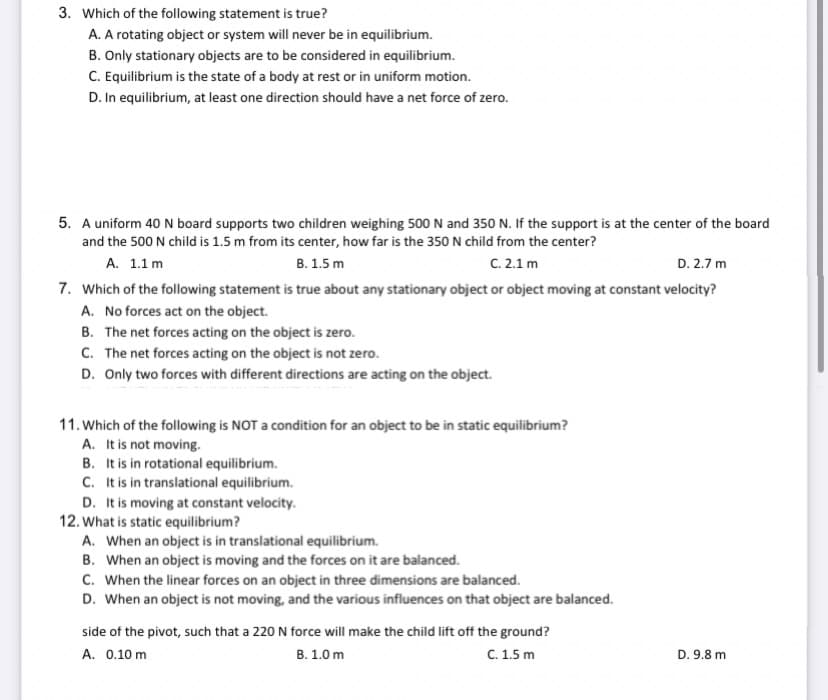3. Which of the following statement is true? A. A rotating object or system will never be in equilibrium. B. Only stationary objects are to be considered in equilibrium. C. Equilibrium is the state of a body at rest or in uniform motion. D. In equilibrium, at least one direction should have a net force of zero.
3. Which of the following statement is true? A. A rotating object or system will never be in equilibrium. B. Only stationary objects are to be considered in equilibrium. C. Equilibrium is the state of a body at rest or in uniform motion. D. In equilibrium, at least one direction should have a net force of zero.
Physics for Scientists and Engineers, Technology Update (No access codes included)
9th Edition
ISBN:9781305116399
Author:Raymond A. Serway, John W. Jewett
Publisher:Raymond A. Serway, John W. Jewett
Chapter12: Static Equilibrium And Elasticity
Section: Chapter Questions
Problem 12.4OQ: Two forces are acting on an object. Which of the following statements is correct? (a) The object is...
Related questions
Question
Multiple choice lang po

Transcribed Image Text:3. Which of the following statement is true?
A. A rotating object or system will never be in equilibrium.
B. Only stationary objects are to be considered in equilibrium.
C. Equilibrium is the state of a body at rest or in uniform motion.
D. In equilibrium, at least one direction should have a net force of zero.
5. A uniform 40 N board supports two children weighing 500 N and 350 N. If the support is at the center of the board
and the 500 N child is 1.5 m from its center, how far is the 350 N child from the center?
А. 1.1 m
В. 1.5 m
C. 2.1 m
D. 2.7 m
7. Which of the following statement is true about any stationary object or object moving at constant velocity?
A. No forces act on the object.
B. The net forces acting on the object is zero.
C. The net forces acting on the object is not zero.
D. Only two forces with different directions are acting on the object.
11. Which of the following is NOT a condition for an object to be in static equilibrium?
A. It is not moving.
B. It is in rotational equilibrium.
C. It is in translational equilibrium.
D. It is moving at constant velocity.
12. What is static equilibrium?
A. When an object is in translational equilibrium.
B. When an object is moving and the forces on it are balanced.
C. When the linear forces on an object in three dimensions are balanced.
D. When an object is not moving, and the various influences on that object are balanced.
side of the pivot, such that a 220 N force will make the child lift off the ground?
A. 0.10 m
В. 1.0 m
C. 1.5 m
D. 9.8 m
Expert Solution
This question has been solved!
Explore an expertly crafted, step-by-step solution for a thorough understanding of key concepts.
This is a popular solution!
Trending now
This is a popular solution!
Step by step
Solved in 2 steps

Knowledge Booster
Learn more about
Need a deep-dive on the concept behind this application? Look no further. Learn more about this topic, physics and related others by exploring similar questions and additional content below.Recommended textbooks for you

Physics for Scientists and Engineers, Technology …
Physics
ISBN:
9781305116399
Author:
Raymond A. Serway, John W. Jewett
Publisher:
Cengage Learning

College Physics
Physics
ISBN:
9781305952300
Author:
Raymond A. Serway, Chris Vuille
Publisher:
Cengage Learning

College Physics
Physics
ISBN:
9781938168000
Author:
Paul Peter Urone, Roger Hinrichs
Publisher:
OpenStax College

Physics for Scientists and Engineers, Technology …
Physics
ISBN:
9781305116399
Author:
Raymond A. Serway, John W. Jewett
Publisher:
Cengage Learning

College Physics
Physics
ISBN:
9781305952300
Author:
Raymond A. Serway, Chris Vuille
Publisher:
Cengage Learning

College Physics
Physics
ISBN:
9781938168000
Author:
Paul Peter Urone, Roger Hinrichs
Publisher:
OpenStax College

College Physics
Physics
ISBN:
9781285737027
Author:
Raymond A. Serway, Chris Vuille
Publisher:
Cengage Learning

Principles of Physics: A Calculus-Based Text
Physics
ISBN:
9781133104261
Author:
Raymond A. Serway, John W. Jewett
Publisher:
Cengage Learning

Glencoe Physics: Principles and Problems, Student…
Physics
ISBN:
9780078807213
Author:
Paul W. Zitzewitz
Publisher:
Glencoe/McGraw-Hill